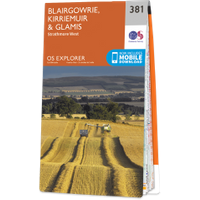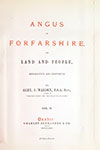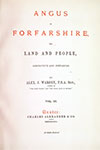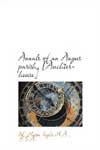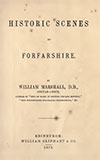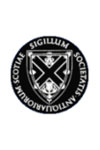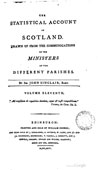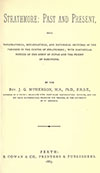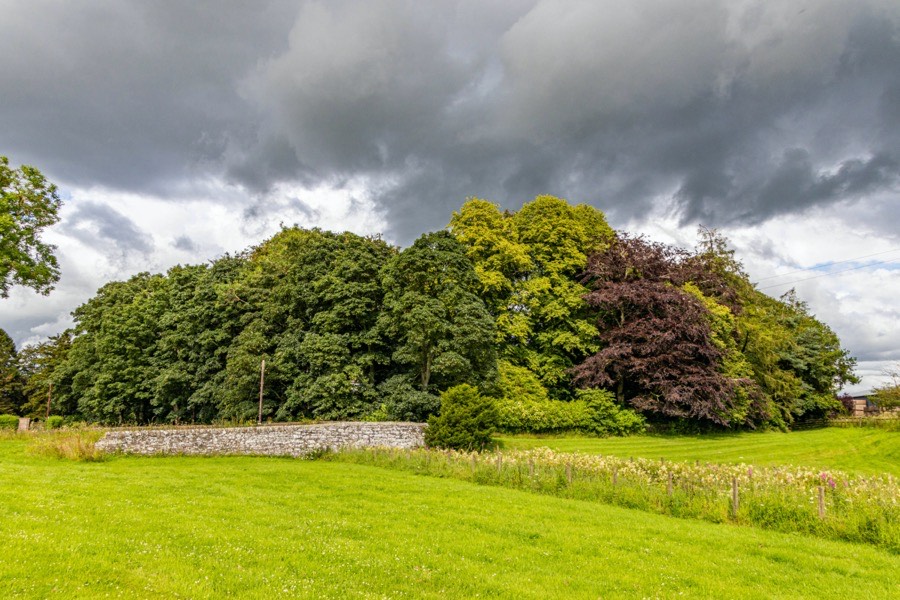

Castleton of Eassie is a large earthwork surrounded by a broad ditch and is thought to be the site of a 12th or 13th century castle.
The early history of the site is not known, however it has been suggested that it may have started out as a crannog. Given the size of the site this may be unlikely. Originally the site was surrounded by boggy ground and may once have stood on the banks of a loch.
The earthwork’s summit measures around 89m north-east to south-west by around 67m across and is approximately rectangular in shape. To the north-east and south-east the mound is protected by a broad ditch measuring up to 15.2m across and up to 5m deep cut from the sandstone bedrock. A causeway across the ditch on the south-east side may be contemporary.

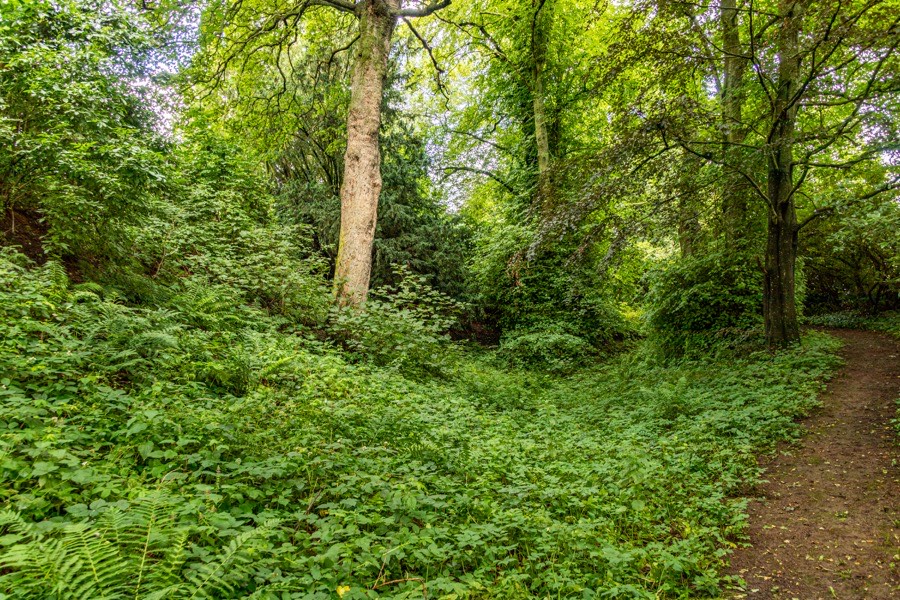
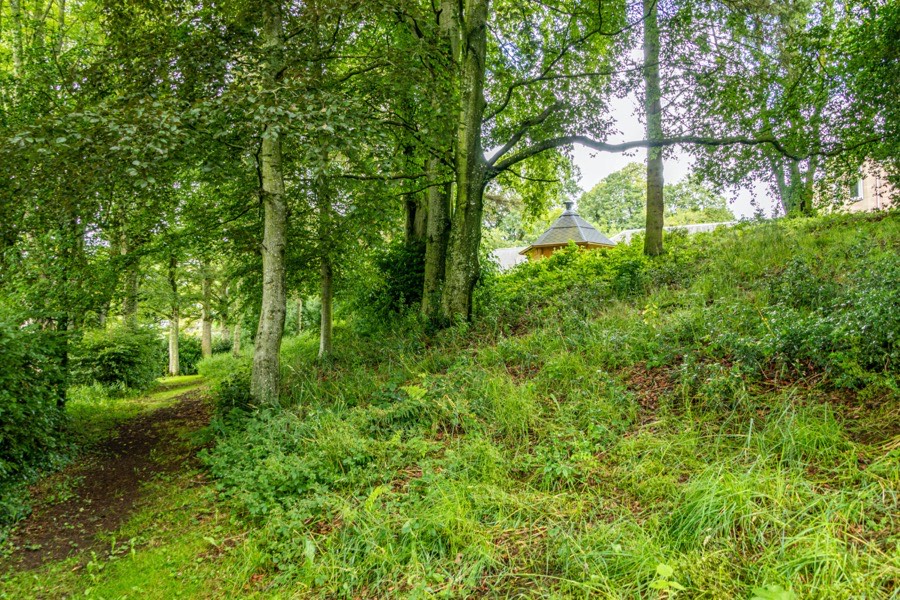
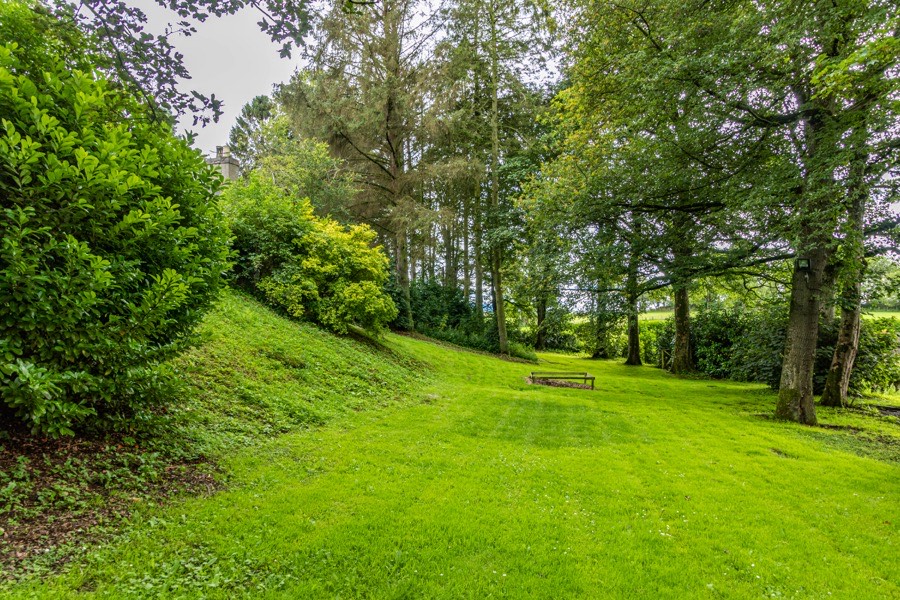
Several 19th century sources refer to a circular mound on the site which may represent a now destroyed motte, however the ditch can appear to follow a rounded course in places and the description would indeed appear to apply to the earthwork.
There was once a Thanage of Eassie and Castleton was later part of the barony of Eassie however I haven’t been able to establish if it was the seat of the barony. In later references to the barony of Eassie the first-mentioned constituent part is Castleton.
The castle would have been on Edward I’s route north from Inverqueich Castle to Forfar Castle in July 1296 and coins minted during the reign of Edward I of England have been found in the vicinity. It has been suggested that the earthwork and castle could have been built by Edward however he is said to have made an encampment around 1000m to the south-east at Ingliston so this would seem unlikely. A spearhead found or “sceptre-head” have also been found on or near the site.
In 1390 Walter Ogilvy was granted a charter of the Kirkton of Eassie and other lands by Isabella Douglas, Countess of Mar, however it isn’t clear if this included Castleton. His son and successor, Alexander Ogilvy or Ogilvie, who in 1389 and 1390 was the Sheriff of Forfar, later owned the barony of Eassie. Alexander was succeeded by his son, Sir Patrick Ogilvie of Auchterhouse, who was Sheriff of Angus.
In 1426 James I confirmed a grant by Sir Patrick, with the consent of his father, Alexander, of various rents from Banffshire which were to be used to build a chaplainry at Garioch (also known as Garvoch or Garvyach). If the rents were not produced then the funds were to be taken from the baronial lands of Auchterhouse and Eassie.
Some time before 1432 Sir Patrick died in a shipwreck off the coast of Brittany, having been made commander-in-chief of the Scottish army in France following the death of Sir John Stewart of Darnley at the Siege of Orléans in 1429. Sir John was a cousin of John Stewart, Earl of Buchan, who had been killed at the Battle of Verneuil in 1424.
Auchterhouse and Eassie passed to Sir Patrick’s eldest son, Alexander Ogilvie, who held them until his death some time between 1470 and 1473 when they were inherited by his only daughter and heiress, Margaret Ogilvie. Some time before 1466 Margaret married James Stewart, 1st Earl of Buchan in the third creation and uncle of James III, and her husband became Lord of Auchterhouse.
In 1478 James III granted to the Earl of Buchan the lands and castle of Auchterhouse, along with the lands of Nevay, Eassie, Kynnalty and Kettins, which the Earl and his wife had resigned.
The Ogilvies may have retained some kind of claim over Eassie as in 1482 the lands of Luntrethin, Arlie, Garloc, Esse, Formale, Fornochty and Kellor were resigned by John Ogilvy de Luntrethin and erected into the free barony of Luntrethin or Lintrathen for him by the King.
In 1528 John Stewart, 3rd Earl of Buchan, had a charter from James V of the barony and lordship of Auchterhouse, Eassie, Nevay, Blacklunans, Drumfork and others which were erected into the barony of Glendowoquhy. The 3rd Earl resigned all his estates and baronies in 1547 and had a new charter of them from Mary, Queen of Scots, with Casteltoun specifically mentioned.
The 3rd Earl resigned his lands and heritable offices to his eldest son, John Stewart, and his son’s heirs in August 1547, however John died at the Battle of Pinke Cleugh a month later. John had married secondly Margaret Ogilvy, daughter of Walter Ogilvy of Boyne, and they had an only daughter, Christian or Christina Stewart.
The 3rd Earl died in 1551 and the infant Christina succeeded her grandfather as Countess of Buchan and was infeft in all her estates including the lands and barony of Eassie made up of Castleton, Alehouse, Brewlands, Newmill of Eassie, Balkeerie and the mill of Glenquharities. Margaret Ogilvy had died when her daughter was just three years of age and so Christina had been placed under the guardianship of Margaret Erskine, wife of Sir Robert Douglas of Lochleven and a mistress of James V.
A year or two before Christina became Countess of Buchan a contract of marriage was arranged for her to James Stewart, later 1st Earl of Moray, the illegitimate son of her guardian and the King. He however married Agnes Keith, daughter of William Keith, 4th Earl Marischal, instead and Christina married his half-brother, Robert Douglas, second son of Margaret Erskine and her husband.
Robert became Earl of Buchan and Sheriff of Banff in his wife’s right but seems to have resigned the the barony of Glendowoquhy as in 1573 the infant James VI granted to Robert Stewart of Todlaw the barony of Glendowoquhy including the the lands and barony of Eassie with Casteltoun, which Christina, Countess of Buchan, with the consent of her husband, Robert, Earl of Buchan, had resigned. However the following year Robert Stewart resigned the the barony of Glendowoquhy in favour of Robert Douglas and Christina. The Earl of Buchan was a supporter of the Regent Moray, the aforementioned James Stewart, 1st Earl of Moray, during the minority of James VI.
Casteltoun is illustrated as what looks like a settlement on Pont’s late 16th century map of Lower Angus, but as what may be a castle named Castelton or Casteltou on his map of Middle Strathmore.
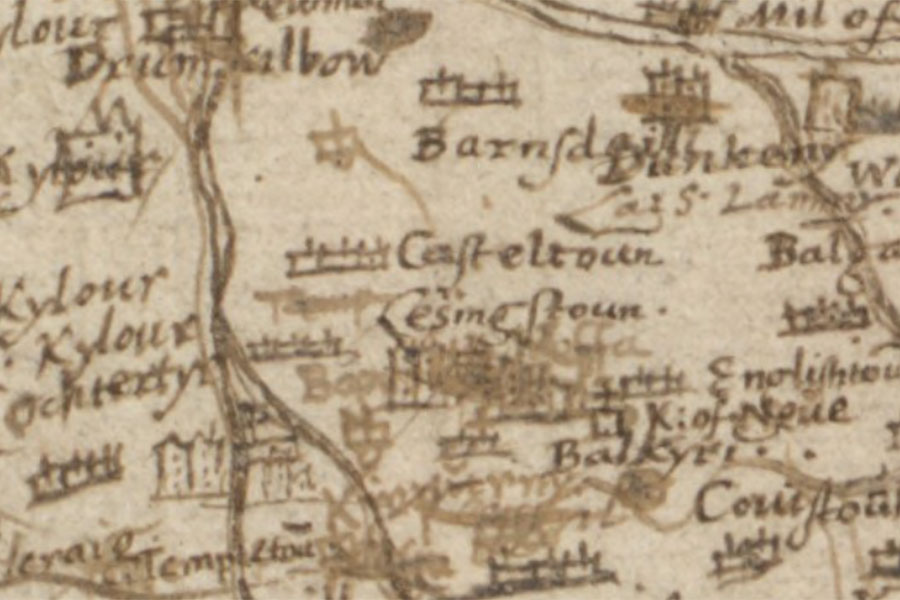
Timothy Pont, c. 1583 – 96map image courtesy of NLS

Timothy Pont, c. 1583 – 96map image courtesy of NLS
The Earl and Countess of Buchan had one son, James Douglas, born about 1580 and three daughters. James succeeded his father in 1586 and was served heir to his mother in 1588. He married Margaret Ogilvy, daughter of Walter, Lord Ogilvy of Deskford, but died in August 1601 before the birth of their only daughter, Mary, in October of the same year.
In 1615 Lady Mary Douglas, 6th Countess of Buchan and heiress of her grandmother, Lady Christina Stewart, Countess of Buchan, was retoured in the baronies of Auchterhouse, Eassie, Nevay, Kettins and others. She married James Erskine, the eldest son of John Erskine, 19th Earl of Mar, and Marie Stewart, daughter of Esme Stewart, Duke of Lennox, who became the 6th Earl of Buchan in his wife’s right.
Following the ascension to the throne of Charles I in 1625 the 6th Earl was made one of the lords of the bedchamber. The Countess died in 1628 and in 1633 Charles I confirmed various lands to the 6th Earl including “the lands and barony of Eassie, with the manor place, tower, fortalice” and the “lands of Castleton”.
The property was marked as a tower named Castelltoun on Gordon’s mid-17th century map of the Brae of Angus.

Robert Gordon, c. 1636 – 52map image courtesy of NLS
Later in the 1630s the 6th Earl of Buchan alienated the barony of Eassie, including the lands of Castleton, to John Leslie, 6th Earl of Rothes, and John Lyon, 2nd Earl of Kinghorne. In 1638 the Earls of Rothes and Kinghorne signed a contract with James Elphinstone, 1st Lord Coupar, and his wife, Margaret Haliburton, granting them the lands and barony of Eassie. The contract was confirmed by Charles I in 1641 following the deaths of the Earl of Buchan and the Earl of Rothes.
The 2nd Earl of Kinghorne married Lady Elizabeth Maule, daughter of Patrick Maule, 1st Earl of Panmure, and died in 1646. He was succeeded by his infant son, Patrick Lyon, in the same year and in 1648 the 3rd Earl of Kinghorne was retoured in the lands and barony of Eassie.
Blaeu’s maps of Scotland were produced around this time but Castleton of Eassie isn’t marked on them. It may be that the castle had fallen out of use by this time.
In 1672 the 3rd Earl of Kinghorne obtained a new charter from Charles II granting him the new title of Earl of Strathmore and Kinghorne and included within the document were “the lands and barrony of Eassie, with the tower, fortalices, maner places”. By 1683 Castleton and Ingliston were owned by John Leslie, 4th Lord Lindores, a descendant of Andrew Leslie, 5th Earl of Rothes.
Little seems to have been written about the ownership of Castleton in the following century. It was marked with a castle symbol and the name Castltoun on Moll’s map of The Shire of Angus from 1745 and is shown on Roy’s slightly later map as a settlement named Castletown situated on boggy ground to the north of a loch.

Herman Moll, 1745map image courtesy of NLS
In 1784 a new bridge was built to the south-west of the earthworks to carry the main road over the Commerton Burn. The route of the main road was later diverted to the south so that this bridge now stands within the grounds of the house.
Ainslie’s map of 1794 shows the name Castle on the north side of the main road illustrated with a small castle-like structure and the settlement of Castleton on the south side. It may be that the main residence was remodelled or a new house built around this time, although if any remnants of an old castle were incorporated into the property then they are no longer visible. In either case the house seems to have been two storeys in height, rectangular in plan and aligned east-north-east to west-south-west with the main entrance on the south façade.
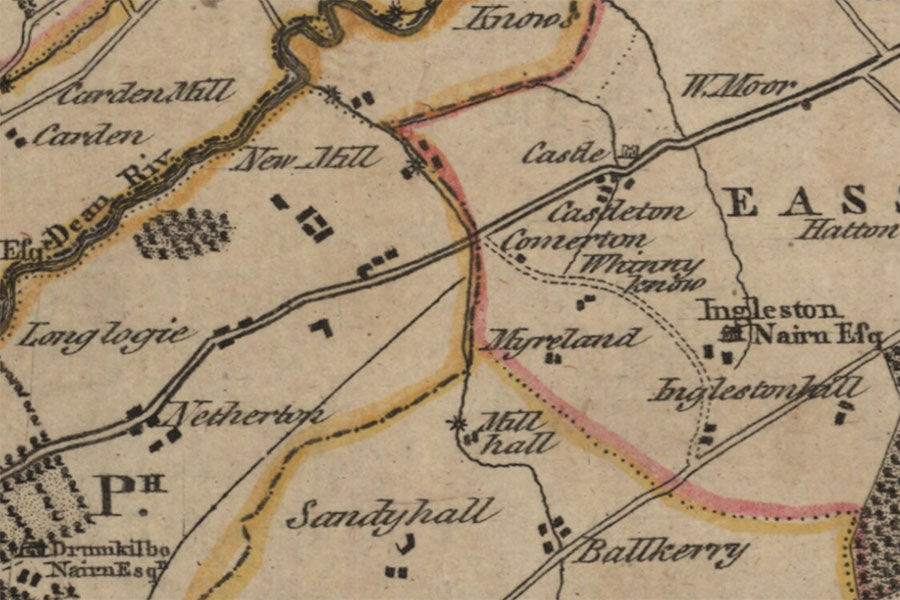
John Ainslie, 1794map image courtesy of NLS
Castleton, along with the neighbouring property of Ingliston, was owned by David Nairn in 1822. This may have been the same David Nairn whose seat was further west along the main road at Drumkilbo. Thomson’s map of 1825 is similar to that of Ainslie’s and uses the same symbol as that for Glamis Castle. Knox’s 1831 map shows a large house named Eassie Castle on the north side of the road and the settlement of Castleton on the south.

James Knox, 1831map image courtesy of NLS
In 1842 the house was referred to variously as the farmhouse of Castle Nairn, Castle-Nairne or Castle Nairne, presumably named for the family who owned it. By this time the house had been enlarged to the north with the addition of a couple of parallel extensions.

Ordnance Survey, 1863map image courtesy of NLS
The present Castleton House is said to have been built for Sir Thomas and Mary Wedderspoon in 1902, with the initials T.W. and M.W. and the date 1902 carved on a pediment high above the entrance.
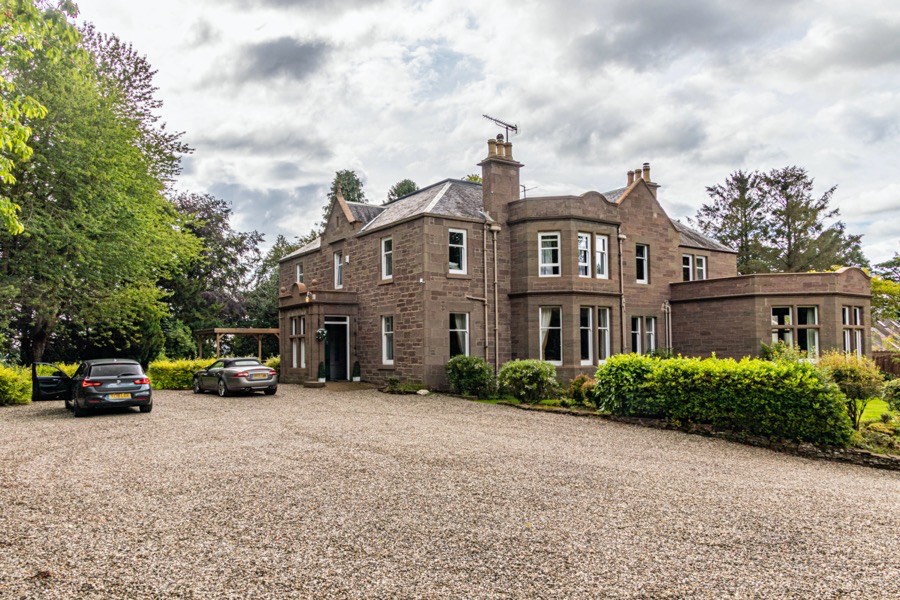

Ordnance Survey, 1902map image courtesy of NLS
The gap between the two northern extensions was filled in, a two storey bay window added to the south end of the east façade and a one storey bayed extension added to the north end of the same side.
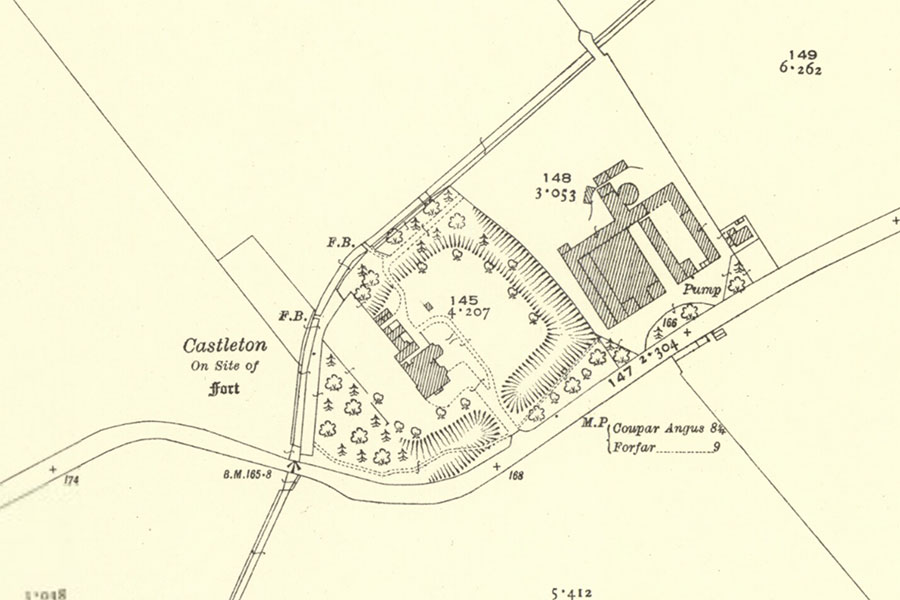
Ordnance Survey, 1924map image courtesy of NLS
The house was extended further to the north-west later in the 20th century, incorporating existing outbuildings into the main house. It remained a private home until 1989 when it was sold and converted into a hotel. In 1990 test pits were dug in an area measuring 20m by 30m to the south-west of Castleton House however no archaeological features were found apart from the pre-19th century ground surface which had survived garden landscaping.
The house operated as an upmarket self-catering holiday let from 2010 and underwent some modernisation between 2015 and 2018. In late 2019 the house reopened as an exclusive-use holiday rental property following a year long program of refurbishment.
Alternative names for Castleton of Eassie
Castelltoun; Castelton; Casteltoun; Castle Nairn; Castle Nairne; Castle-Nairne; Castletou; Castletoun; Castletown; Castltoun; Eassie Castle; Eissie; Esche; Esse; Essie; Essy




